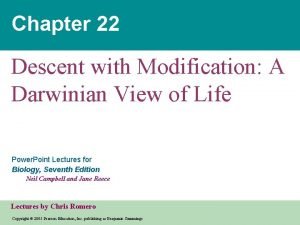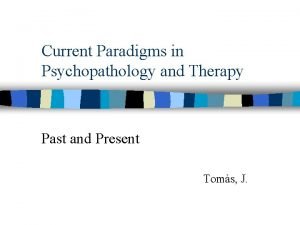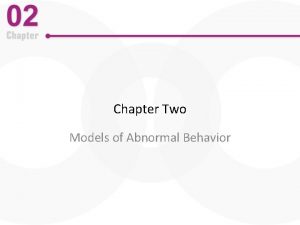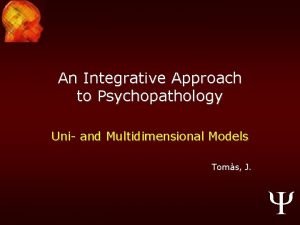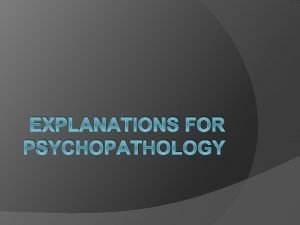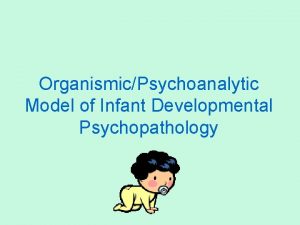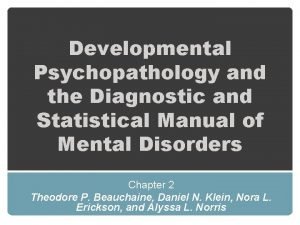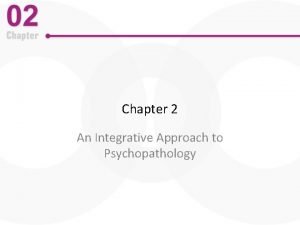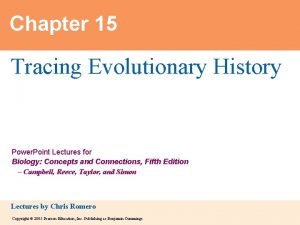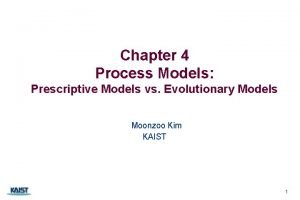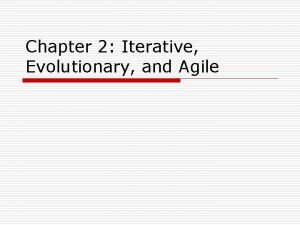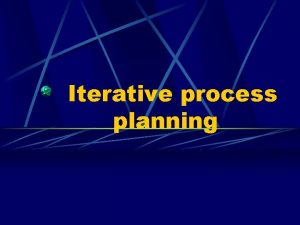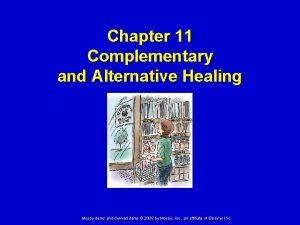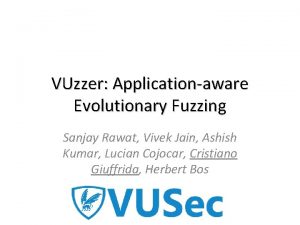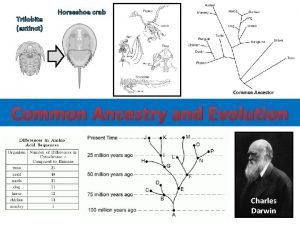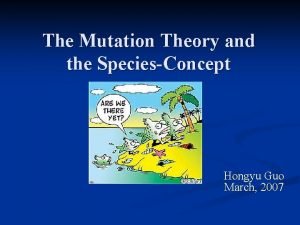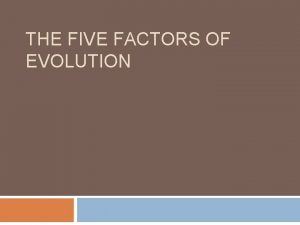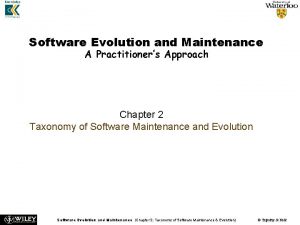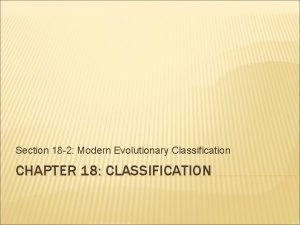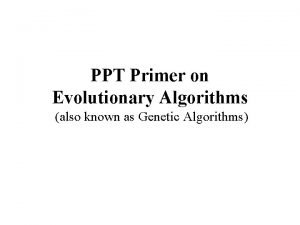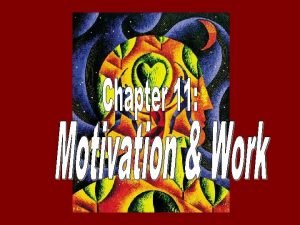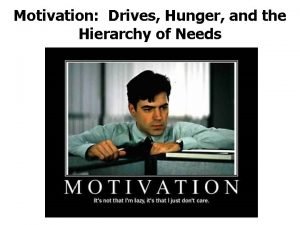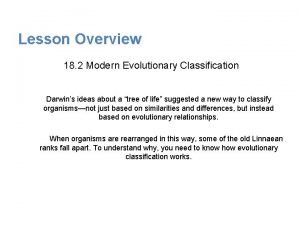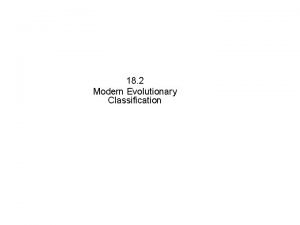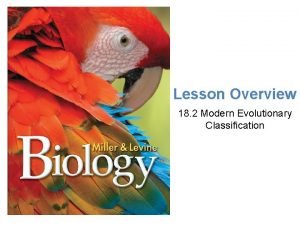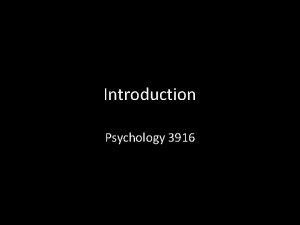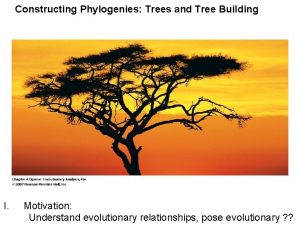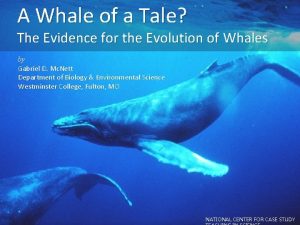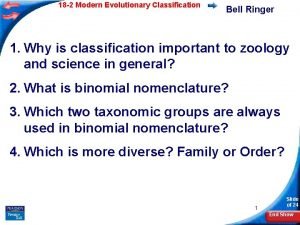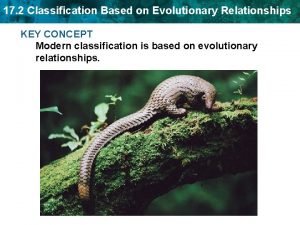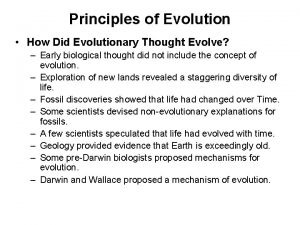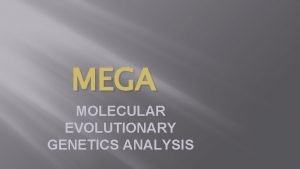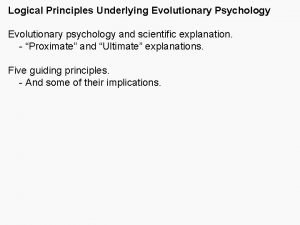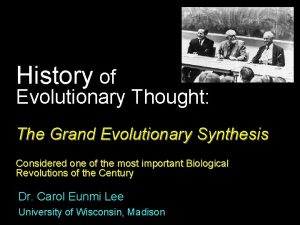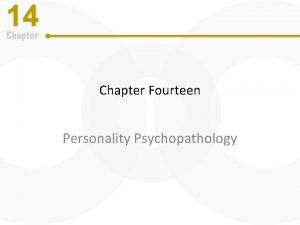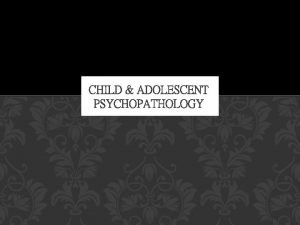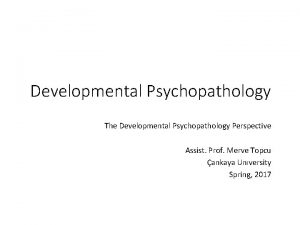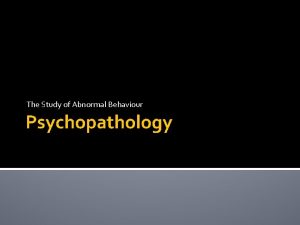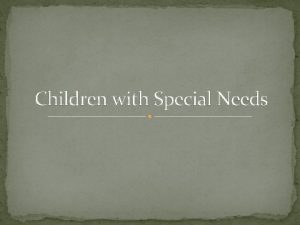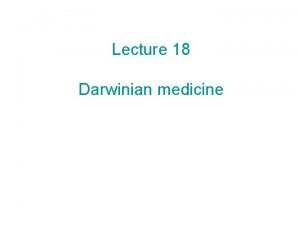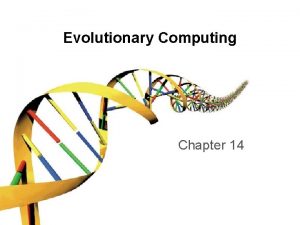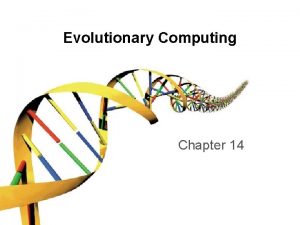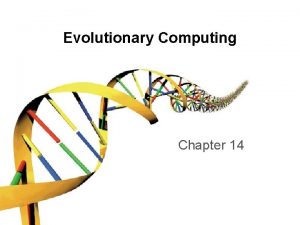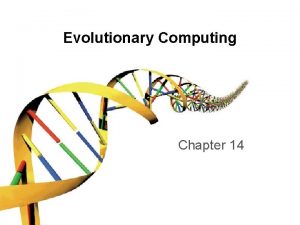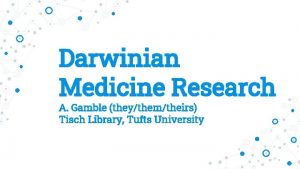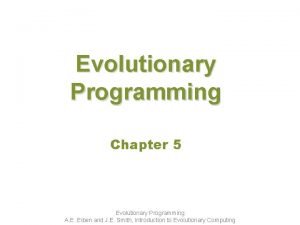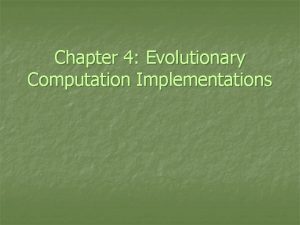Chapter 12 Evolutionary Psychopathology and Darwinian Medicine Division























































- Slides: 55

Chapter 12 Evolutionary Psychopathology and Darwinian Medicine

Division • Evolutionary Psychopathology – Study of mental illness within an evolutionary context • Darwinian Medicine – Evolutionary theory applied to both psychiatric and non-psychiatric health issues

Levels • Traditional – Proximate – Etiology (cause) and pathogenesis (mechanism) – “How” questions • Evolutionary medicine – Ultimate – “Why” questions

Parasites and Hosts • “Arms race” • Red Queen theory • Adaptation and counter adaptation

Symptoms • Traditionally, all symptoms seen as pathological (to be treated) • Adaptation in parasite – To propagate copies • Adaptation in host – To destroy/resist/expel parasite – Defense mechanisms evolved for protection – Such symptoms actually beneficial in long run

Bacterial Infection • Single celled microbes • Leukocyte endogenous mediator (LEM) released by body when infected with bacteria – Raises body temperature – Iron withdrawal from bloodstream (into liver) – Symptomatically --> fever and fatigue – Bacteria need iron to reproduce and are susceptible to higher temperatures • Treatment of fever and iron supplements counter body’s evolved defenses

Cholera (Vibrio cholerae) • Parasite induced symptoms • Benefit spread of parasite – Contaminated water – Infection induces diarrhoea; dehydration can kill host quickly – But, passes more parasites back into water system – Spreads to more hosts – Fast replicating microbe

Bubonic Plague (Yersinia pestis) • Most often, person infected by bite from flea, infected by biting a rodent that was infected by a bite from a flea • Bacteria multiply in flea, blocking its stomach, causing it to starve; hungry flea voraciously bites host trying to feed, expelling bacteria in the processes Source: en. wikipedia. org/wiki/ Bubonic_plague

• In mammals, bacteria reproduces in cells, collecting in lymph nodes • Eventually so many bacteria in lymph nodes that they “spill” out into bloodstream • Septicimic form: infect organs, cause bleeding in and under skin – Contact with broken skin can infect other hosts • Pneumonic form: infects lungs – Coughing transmits bacteria to other hosts on airborn repiratory droplets • 1347 -1351: killed 1/3 to 1/2 of European population Source: www. insecta-inspecta. com/fleas/bdeath/Art_music. html

Viral Infections • Submicroscopic strands of DNA or RNA • “Assisted” self-replicating infectious agent – Need another organism’s cells to reproduce – Obligate parasites • E. g. , rabies, yellow fever, smallpox, West Nile, herpes

Ebola • Group of filoviruses • Early symptoms: headache; joint, muscle, abdominal pain; weakness; nausea • Later symptoms: diarrhea, vomiting, internal and external hemorrhages, coughing blood • Transmitted via body fluid contact • 50 -90% fatal Source: en. wikipedia. org/wiki/Ebola

Parasite/Host Benefit Crossover • Some symptoms benefit both parasite and host • E. g. , coughing expels parasite from host, but spreads it to other hosts • Consider selfish gene theory here

Immune System • Lymphocytes – B-cells (from bone marrow) and T-cells (from thymus) • Antigens (foreign molecules) activate immune system – B-cells produce antibodies (proteins) that circulate in blood and attach to antigens, marking them for destruction by white blood cell macrophages – T-cells also attack antigen and help with antibody production

Complexity • Millions of different antigens • Lock (antibody) and key (antigen) analogy • Can’t store millions of of each antibody ready and waiting, but can store a few of each type • When specific antigen identified a lymphocyte, that lymphocyte starts replicating rapidly to combat infection • With time, our immune systems have evolved (and stored) the genes to make the various antibodies

MHC • Major histocompatibility complex (MHC) • Genes – Code for disease detectors (antibodies) in the immune system • In humans – Human leukocyte antigen (HLA)

In Mice • Male mice secrete MHC in urine • Female mouse meets males – Smells urine – Preference for mating with male with MHC most different from her own

In Humans • Don’t usually smell pee. . . • Sweat – MHC • Saliva? – Kissing?

Claus Wedekind • 49 men • Wear T-shirt 2 days; no spicy food, perfumes, etc. • 44 women smelled shirts • Rated for sexiness, pleasantness, intensity • Women prefer scents of men with maximally different MHC

Women’s Sense of Smell • Most sensitive during ovulation – Conception • Contraceptive pill – Interferes with sense of smell – In Wedekind’s study, no correlation between preferences and MHC

HLAs • A variety of HLAs – A 1, A 2, B, DR • Rate perfumes for self or other to wear • Positive correlation between HLA-As and perfume for self – Preferences for self, but not for other (advertising? )

MHCs and Like-Avoidance • Variability in the population, in offspring • Heterozygous condition may confer better disease resistance • “Hybrid vigour” • Remember, parasite and host are constantly “upgrading” with new adaptations to combat each other’s defenses

Blood Groups • A, B, AB, O • Offer protection against various diseases • Cholera – AB most resistant (virtually immune) – Then, A, B, and O least resistant – So why doesn’t O vanish from population? • Malaria – Type O more resistant – Also, maybe less likely to get some cancers

Hutterites of North Dakota • Small communities • Not much outbreeding • Marriages of people with matched MHCs – Fewer pregnancies – More miscarriages

Psychiatric Problems • Psychiatric disorders not (usually) due to parasites • Genes and/or environmental effects • Why hasn’t evolution selected against them?

Pleiotropy Argument • Genes’ predispositions to psychiatric disorders may also have inclusive fitness benefits • Genes can have multiple phenotypic effects • Negative effects of a gene may be maintained in gene pool if positive effects outweigh them

Time Lag Argument • Environmental differences from EEA; still adapting to cope • Environment can shift rapidly • Humans can directly or indirectly speed environmental change • Selective pressures still “catching up”

Compromise Argument • Design compromises, not genetic flaws • Selective pressures act on inclusive fitness • Evolution doesn’t act to design optimal systems • Sufficient degree of differential reproductive success is the requirement

Trait Variation Argument • Normal distribution curve for traits in population • Individuals’ characteristics due to genetic and environmental effects • Most individuals in middle; very few on the extremes

Anxiety • • Very basic and adaptive Feeling of apprehension, nervousness Xenophobia Very, very ancestral

Mammals • Eomaia (~125 mya) • Primate ancestor very like modern tree shrew • Small insectivores • A meal for anything bigger www. hoglezoo. org/animals/view. php? id=183 en. wikipedia. org/wiki/Eomaia www. ryanphotographic. com/images/JPEGS/Tree%20 shrew. jpg

Benefit of Anxiety • Focuses attention • Prepares specific defense reactions – Freeze, flight, fight • “Smoke detector” model – “Better to be safe than dead” – Consequence of being anxious when not necessary (e. g. , false alarm) better than not being anxious when you should

Evolved for Constant Anxiety? • For short periods, not problematic • Difficulties arise when constantly in this state – Physiological stress – Costs in terms of lost time foraging, mating, childrearing, etc.

Anxiety Disorders • Time lag – Haven’t adapted yet to limited threats in Western society – Alternatively, modern features can allow you to stay in anxious state • E. g. , agoraphobia (instead of having to go out to forage, just order delivery and stay in) • Trait variation – Problems with anxiety when at the extremes (too little or too much)

Depression • Affective disorders – Mood disturbances and depression • Reactive depression – Normal response to specific life events • Endogenous/clinical depression – Severe, long-term, may not be related to specific event • Unipolar depression and bipolar disorder • Three classes of evolutionary models

Ultimate Cause Models • Adaptive trait – Depression as response to adverse condition – Provides motivation for some action • Pleiotropy – Genes increasing inclusive fitness (e. g. , creativity, introspection) also predispose individual to depression • Trait variation – Chance mixing of genes at conception; outliers in population

Developmental Disruption Models • Environmental developmental disruption affects genetically normal individual – E. g. , toxins, neurological damage • Adverse social effects – E. g. , abandonment, lack of social interaction • Generally, phenotypic interpretations

Ultimate-Proximate Interactions • • • Social competition hypothesis (Price, 1967) Decline in social status Interpersonal conflict resulting in loss Fall in status/personal loss triggers depression Depression appears less threatening, ends conflict (communication) • Depression allows individual to accept defeat

Serotonin • Vervet monkeys • Alpha has highest serotonin levels • If alpha loses status, behaviourally appears depressed, and serotonin levels drop to low • Give Prozac (selective serotonin reuptake inhibitor) – Fallen alpha stops depressed behaviour – Non-alpha male on Prozac becomes alpha

Possible Modern Contributors • Mass communication • In EEA all comparison was to others in relatively small social group • With TV and movies we compare to the “best” from a much larger population • Physical comparison to stars, models leads to negative body image; taken to extreme, depression

• Loss of family and community structure • Quite different from EEA • Kinship support networks (indirect fitness benefits) • Small social groups promote reciprocal altruism (“support networks”) • Postpartum depression – Possibly a non-linguistic way to communicate stress and the need for assistance immediately after childbirth – If no support immediately provided, depression ramps up to make communication more obvious

Schizophrenia • About 1/100 people • “Split mind” – Cognitive, emotional and motivation processes • Hallucinations, delusions, affective disorders, bizarre beliefs • Difficulty maintaining social relationships • Chronic and acute forms

Genetics • Long recognized to run in families • As r-value with schizophrenic increases, so does the probability of having the disorder • But, not strictly hereditary – Siblings, 7. 3% (r = 0. 5) – Dizygotic twins, 12. 08 (r = 0. 5) – Monozygotic twins, 44. 3 (r = 1. 0)

Diathesis-Stress Model • Doesn’t follow strict Mendellian rules • Individual may have genes for schizophrenia, but only phenotypically express them after particularly stressful life event • Genes create predisposition

Lateralization of Language Hypothesis • Crow (1995) • Suggests schizophrenia developed recently – 100, 000 - 150, 000 years ago • Linked to development of language • Lateralization of language “centres” – Left for semantics, phonetics; right for emotional state identification

• Schizophrenics have atypical interaction between hemispheres for language processing • Don’t process “sub-vocal” language as normal – Could explain delusions and auditory hallucinations

Support? • Indirect – More left handed schizophrenics than usual – Usual left hemisphere linguistic processing often lost – Speech output and input may be located in opposite hemispheres in people with abnormal handedness • Speculative at this point

Issues • Not all people with abnormal handedness are schizophrenic • Doesn’t explain why, evolutionarily, it wouldn’t be selected against – Crow argues it is a byproduct of human genetic variability with respect to genes linked to language – Unclear if there could be any selective advantage; creativity has been suggested, but not well supported

Group-Splitting Hypothesis • Stevens and Price (1996) • Possible leadership value • Disaffected individuals in group may look for radical ideas from a leader to reform societal rules • The delusions, “unorthodox” ideas, and charismatic focus may be appealing to those looking for change

• Thus, schizophrenic is elevated to leader • Confers fitness advantages • There is historical precedence for radical political, religious, ideological leaders to attract followers, “groupies”; gain many sexual opportunities • Problems – Historically rare, most schizophrenics are actually not coherent or charismatic, don’t know historic figures really were schizophrenic

Adaptive Paranoia • Paranoid delusions frequent in schizophrenics • Development of genes for “suspiciousness” may have been adaptive in EEA – Reduce being cheated, avoid dangerous situations, etc. • But, full paranoid delusions more debilitating than useful; why?

Psychopathy • Antisocial personality disorder • Lack of empathy, callous, exploit others without feeling guilt or shame • Prone to instant gratification • May be quite charming and charismatic • Machiavellian Intelligence • Don’t lack To. M

Reciprocity • Reciprocity important in social situations • If most individuals are reciprocators, being a cheater could be very adaptive • But, only if numbers of cheaters remains low • Estimates that 3% of males and 1% females are psychopaths, but that only half get caught – 50: 50 success: failure may be self-regulating • Politicians, business executives, lawyers…

Males • To avoid being caught, move from group to group • Easier for males in EEA • Freeloading may be a more adaptive strategy for mobile males than females

Females • Histrionic personality disorder • Attention seeking, self-centred, narcissistic • Not the same as psychopaths, but prone to social defection • More common in females than males • Gain attention, resources, mating opportunities with behaviour • Frequently avoid reciprocating by feigned illness

Environment • Mealey (1995) • Predisposition toward psychopathy • Environmental conditions drive individual toward or away from predisposition
 Descent with modification: a darwinian view of life
Descent with modification: a darwinian view of life Darwism
Darwism Biological paradigm of psychopathology
Biological paradigm of psychopathology Multipath model of psychopathology
Multipath model of psychopathology Multidimensional integrative approach to psychopathology
Multidimensional integrative approach to psychopathology What is psychopathology
What is psychopathology Bacteria causing syphilis
Bacteria causing syphilis Garrett model of speech production
Garrett model of speech production Psychopathology
Psychopathology Developmental psychopathology approach
Developmental psychopathology approach Multidimensional approach to psychopathology
Multidimensional approach to psychopathology Short division vs long division
Short division vs long division Long division terminology
Long division terminology Synthetic divison
Synthetic divison Binomial long division
Binomial long division Evolution section 3 shaping evolutionary theory
Evolution section 3 shaping evolutionary theory Chapter 15 tracing evolutionary history
Chapter 15 tracing evolutionary history Chapter 15 section 3 shaping evolutionary theory
Chapter 15 section 3 shaping evolutionary theory Chapter 15 darwin's theory of evolution
Chapter 15 darwin's theory of evolution Difference between prescriptive and evolutionary model
Difference between prescriptive and evolutionary model Iterative and evolutionary development
Iterative and evolutionary development Conventional and evolutionary work breakdown structure
Conventional and evolutionary work breakdown structure Chapter 1 history of medicine and pharmacy
Chapter 1 history of medicine and pharmacy Chapter 11 complementary and alternative medicine
Chapter 11 complementary and alternative medicine Evolutionary perspective of psychology
Evolutionary perspective of psychology Vuzzer
Vuzzer Trilobite and horseshoe crab similarities
Trilobite and horseshoe crab similarities Modern evolutionary synthesis
Modern evolutionary synthesis Evolutionary factors
Evolutionary factors Evolutionary maintenance
Evolutionary maintenance Evolutionary software process models
Evolutionary software process models Section 18-2 modern phylogenetic taxonomy
Section 18-2 modern phylogenetic taxonomy Evolutionary computing ppt
Evolutionary computing ppt Phylogenetic relationship definition
Phylogenetic relationship definition Motivation is defined as
Motivation is defined as Evolutionary theory of motivation
Evolutionary theory of motivation What do we call a need or desire that energizes behavior
What do we call a need or desire that energizes behavior Optimal arousal theory
Optimal arousal theory Evolutionary theory of motivation
Evolutionary theory of motivation 7 perspectives in psychology
7 perspectives in psychology Modern evolutionary classification
Modern evolutionary classification Section 18-2 modern evolutionary classification
Section 18-2 modern evolutionary classification 18-2 modern evolutionary classification
18-2 modern evolutionary classification Introduction to evolutionary computing
Introduction to evolutionary computing Evolutionary perspective of psychology
Evolutionary perspective of psychology Whale evolutionary tree
Whale evolutionary tree Whale evolutionary tree
Whale evolutionary tree Red panda life cycle
Red panda life cycle Section 18-2 modern evolutionary classification
Section 18-2 modern evolutionary classification Classification is based on evolutionary relationships
Classification is based on evolutionary relationships Classification based on evolutionary relationships
Classification based on evolutionary relationships History of evolutionary thought
History of evolutionary thought Molecular evolutionary genetics analysis download
Molecular evolutionary genetics analysis download Evolutionary psychology questions
Evolutionary psychology questions History of evolutionary thought
History of evolutionary thought Andrea yates evolutionary perspective
Andrea yates evolutionary perspective
